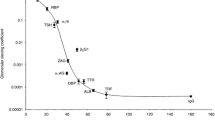Abstract
Proteinuria is defined as the temporary or continuous detection of proteins in the urine, which exceeds an amount of 150–200 mg per 24 h, using a base of urine production of 1,500 ml a day. Regular protein excretion consists of approximately 30 % globulins, 30 % albumin, and 40 % of other proteins, especially Tamm-Horsfall glycoprotein (uromodulin, excreted primarily by the kidney).
Access provided by Autonomous University of Puebla. Download chapter PDF
Similar content being viewed by others
Keywords
These keywords were added by machine and not by the authors. This process is experimental and the keywords may be updated as the learning algorithm improves.
1 Definition
Proteinuria is defined as the temporary or continuous detection of proteins in the urine, which exceeds an amount of 150–200 mg per 24 h, using a base of urine production of 1,500 ml a day. Regular protein excretion consists of approximately 30 % globulins, 30 % albumin, and 40 % of other proteins, especially Tamm-Horsfall glycoprotein (uromodulin, excreted primarily by the kidney).
In a healthy kidney, limitation of protein loss is regulated by the glomerular filter, with a filtration barrier for proteins larger than 50 kDa and especially negative electrically charged molecules, and the tubular reabsorption of smaller proteins and amino acids which passed the glomerular membrane. Therefore, proteinuria is subdivided into different categories: glomerular (prevalent heavy molecular weight), tubular (prevalent small molecular weight), overflow (increased serum protein concentrations), and also postrenal proteinuria (increased renal excretion or associated infection). Table 4.1 summarizes typical marker proteins.
Microalbuminuria, characterized as a 30–300 mg loss in 24 h or a urine concentration of 20–200 mg albumin per liter, should be considered in patients with diabetes mellitus and/or hypertension as an early marker for nephropathy.
2 Medical History
In most cases proteinuria is not a symptom reported by the patient himself/herself. Generally proteinuria is either found during a preventive medical checkup or identified within specific laboratory urine analysis in case of a suspected diagnosis or proved disease. Only in rare cases the patient presents with the specific symptom of foaming urine during micturition.
The initial medical history should focus on the timing of proteinuria. In case of short-term proteinuria, typical signs of infection (fever, exudation, dysuria, malaise) and emotional and physical stress should be explored. Especially in young men, intermittent >and light proteinuria is often seen as a so-called orthostatic proteinuria, which can be excluded by repeated morning urine sample analysis. In case of persistent proteinuria, a wide range of diseases with nephrotoxic potential are known. Therefore, a comprehensive anamnesis including acute and chronic diseases, as well as cancer with potential paraneoplastic protein production, should be investigated. Advanced proteinuria can lead to hypoproteinemia with a decreased oncotic pressure resulting in edemas and ascites.
3 Diagnostics
Dipstick analysis is the first step to detect proteinuria. The dye for protein analysis changes due to a pH shift. Dipstick tests are most sensitive to albumin; therefore, false-negative results could be obtained, if albumin excretion is not increased (e.g., in case of a Bence Jones proteinuria) or if the urine sample is highly diluted or alkaline. Standard dipstick tests will also not detect microalbuminuria.
If proteinuria is present and reasons for short-term proteinuria (especially urinary tract infection) are excluded, a quantification of the amount of protein loss should be performed over a 24-hour period. Protein electrophoresis of the urine unveils the different molecules of proteinuria based on their molecular weight, which enables the categorization in Table 4.1. If a paraneoplastic “overflow” proteinuria is suspected, immunoelectrophoresis and immunofixation are the methods of choice. Quantification of specific proteins could be achieved either by urine (immuno-) nephelometry or turbidimetry.
In case of continuous proteinuria, urine analysis should be accompanied by the examination of the urine sediment (focus on dysmorphic erythrocytes and urinary casts in case of glomerulonephritis) as well as serum protein analysis.

References
Herold G. Internal medicine. 1st ed. Gerd Herold: Cologne; 2011.
Campbell MF, Wein AJ, Kavoussi LR. Campbell-Walsh urology/editor-in-chief, Alan J. Wein; editors, Kavoussi LR, Novick AC, Partin AW, Peters CA et al. 9th ed. Clinical Decision Making. Evaluation of the Urologic Patient: History, Physical Examination, and Urinanalysis Philadelphia: W.B. Saunders; 2007;1:100–103.
Schmidt RF, Lang F, Heckmann M. Physiologie des Menschen: mit Pathophysiologie. 31st ed. Berlin/Heidelberg/New York: Springer; 2010.
Author information
Authors and Affiliations
Corresponding author
Editor information
Editors and Affiliations
Rights and permissions
Copyright information
© 2014 Springer-Verlag Berlin Heidelberg
About this chapter
Cite this chapter
Amend, B., Sievert, KD. (2014). Proteinuria. In: Merseburger, A., Kuczyk, M., Moul, J. (eds) Urology at a Glance. Springer, Berlin, Heidelberg. https://doi.org/10.1007/978-3-642-54859-8_4
Download citation
DOI: https://doi.org/10.1007/978-3-642-54859-8_4
Published:
Publisher Name: Springer, Berlin, Heidelberg
Print ISBN: 978-3-642-54858-1
Online ISBN: 978-3-642-54859-8
eBook Packages: MedicineMedicine (R0)




